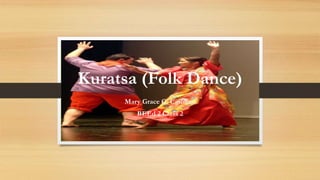
PE2 (report).pptx
- 1. Kuratsa (Folk Dance) Mary Grace C. Carolino BEEd 2 Class 2
- 2. KURATSA – The Kuratsa is a Filipino traditional Dance of Courtship where the male approaches and courts a lady in a form of a dance. It depicts the courtship between the rooster and the hen. – The Kuratsa is highly favored by the Visayan people especially the Waray people of the Eastern Visayas region in the Philippines and highlights every important occasion in the Eastern Visayas communities. – It is a dance for weddings and fiestas, the Kuratsa serves as the traditional money dance where guests take turns pinning money on the bride and groom's attire. This symbolizes friends' and families' wishes for good luck and prosperity in the couple's future.
- 3. KURATSA The dance is performed in three parts, with three different rhythms. 1. The dancing couple starts the performance with a ballroom waltz. 2. Then the music shifts to a faster beat for the "chasing" scene, in which the female dancer flees and the male pursues her all across the dance floor. 3. The tempo picks up even more for the final part, in which the chase ends with a furiously flirtatious scene. The female is won over, and the male imitates a flamboyant bird in a mating dance.
- 4. HISTORY OF KURATSA The Kuratsa is believed to be a Mexican import. Kuratsa (pronounced koo-rah-cha) is a dance inspired by the Mexican La Cucaracha folk dance. The dance also features Flamenco-like movements, reflecting the fact that the Philippines were under Spanish rule from 1565 to 1868. Popular versions of this dance exist in Samar can be classified as the Kuratsa Menor (the usual favorite) and the many versions of the daring Kuratsa Mayor. New genres of Kuratsa evolved as a result of necessity, like-as the name implies- Kuratsa kanan Kadam-an and a very funny Kuratsa nga Pinayungan appropriate for rainy days.
- 5. MUSIC PLAYED IN KURATSA Before music recording was invented, kuratsa music was played by a rondalla or a live brass band. Traditional musicians have a vast repertoire of kuratsa music-the menor or mayor (minor or major scale) in several variations of the playful running melodies. Kuratsa music now has been popularized in the form of the compact disc.
- 6. COSTUME (KURATSA) Female Costume – patadyong with camisa or kimona, with a soft panuelo; white or anycolored trousers Male Costume – barong tagalog or camisa de chino
- 7. STEPS IN KURATSA The four basic parts/steps 1. walking toward each other with a waving motion of the hand; 2. a sideways swaying motion ending with a kick; 3. a faster, more flirtatious step-together section; 4. and finally, the courtship phase with more hip action and shimmying.